The following tables and figures provide more detailed analyses to those summarised in the article “Patient acceptance of SNAP assessment varies according to reason for presenting: an exploration” submitted/published as a research letter in Australian Family Physician.
About the scenarios and the survey instrument
Participants read the following information sheet prior to answering the questions:
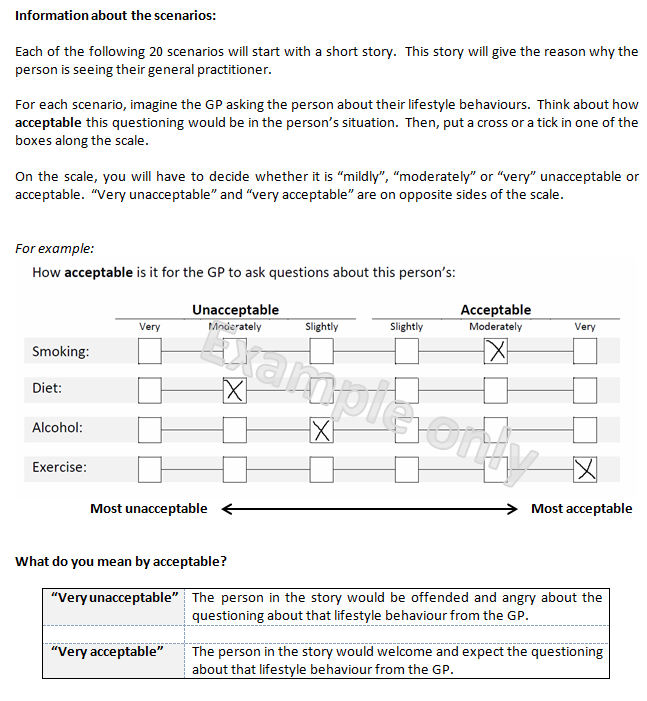
Methods
We re-analysed data from the 66 questionnaire respondents from the intervention arm of the survey experiment published in Australian Family Physician (Tam et al. 2015). In brief, the participants were adult patients attending a general practice in Sydney, Australia in 2014, two-thirds were female, with a mean age of 53.6 years. Full demographics are available in that paper.
These participants rated the acceptability of GP enquiry (“unacceptable”, “ambivalent”, or “acceptable”) of each of the four SNAP factors to twenty clinical vignettes. The vignettes were simple, written to a fifth grade student reading level, and based on the most frequent reasons for encounter and problems managed in Australian general practice.
We ranked the vignette acceptability data and report them descriptively. We used Friedman’s two-way ANOVA by ranks to analyse for differences in SNAP factor acceptability within the vignettes, and Wilcoxon signed rank test between specific factors (IBM SPSS Statistics 23).
The results
The data is available here (Excel spreadsheet).
Table 1 – GP enquiry of SNAP risk factors – ranked by patient acceptability
TABLE 2 – Within-vignette SNAP factor acceptability variation
Table 2 summaries the details from the individual scenarios and charts below.
- RED = Unacceptable
- GREY = Ambivalent
- GREEN = Acceptable
Scenario 1
A person feels well and doesn’t think that they have any health problems. However, they haven’t been to the doctor for some time, and decide that it is time for a check-up at the GP clinic.
How acceptable is it for the GP to ask questions about this person’s:
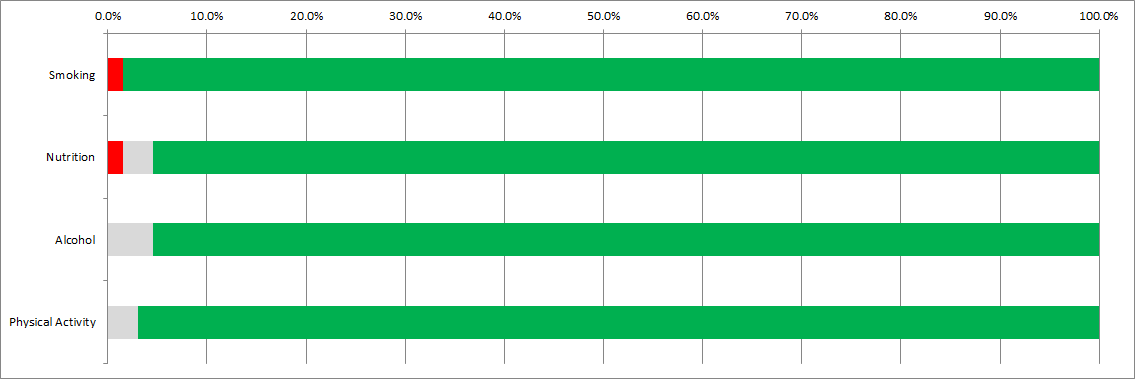
Friedman’s two-way ANOVA by ranks:
- p = 0.73
- no statistically significant differences between the acceptability ratings of the SNAP factors in this scenario
Scenario 2
A person feels well and doesn’t think that they have any new health issues. They take a regular prescribed medicine, which is about to run out. They make an appointment to see the GP to get a new prescription.
How acceptable is it for the GP to ask questions about this person’s:
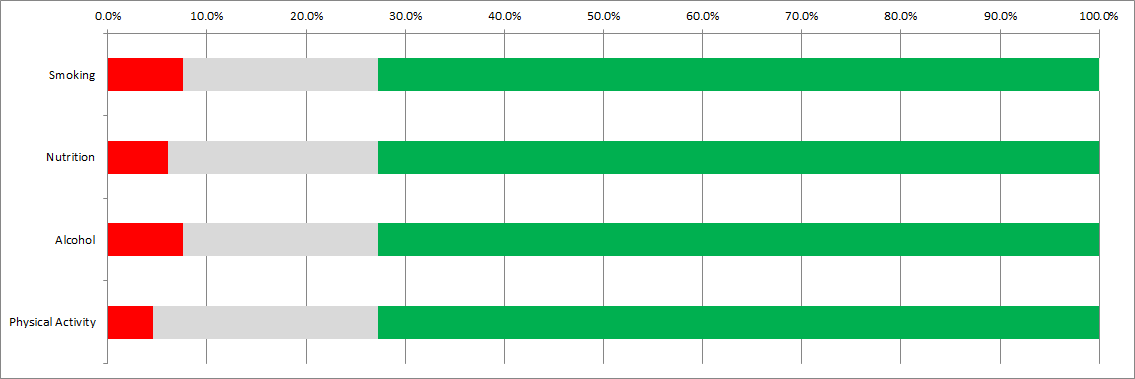
Friedman’s two-way ANOVA by ranks:
- p = 0.19
- no statistically significant differences between the acceptability ratings of the SNAP factors in this scenario
Scenario 3
A person recently had some blood tests performed, after seeing their GP a week ago. They make a follow up appointment to see the GP for the results.
How acceptable is it for the GP to ask questions about this person’s:
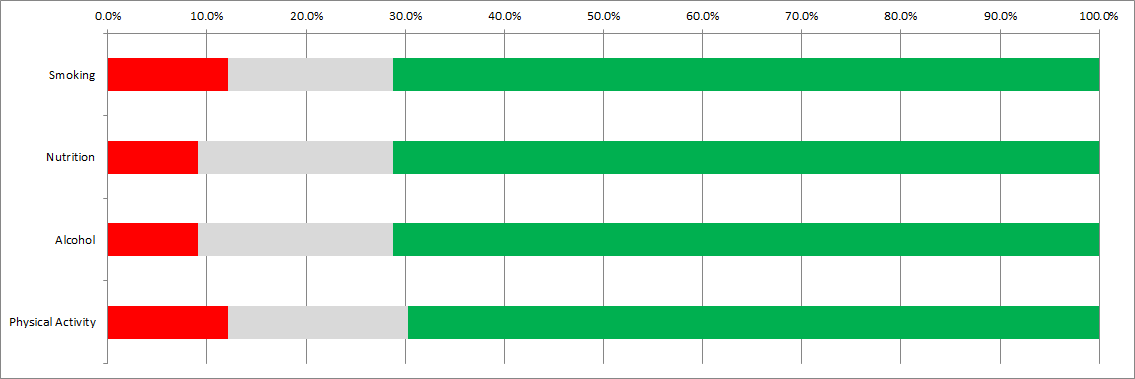
Friedman’s two-way ANOVA by ranks:
- p = 0.39
- no statistically significant differences between the acceptability ratings of the SNAP factors in this scenario
Scenario 4
A person has been sick with a cough. The cough is bad enough that they decide to see the GP about this problem.
How acceptable is it for the GP to ask questions about this person’s:
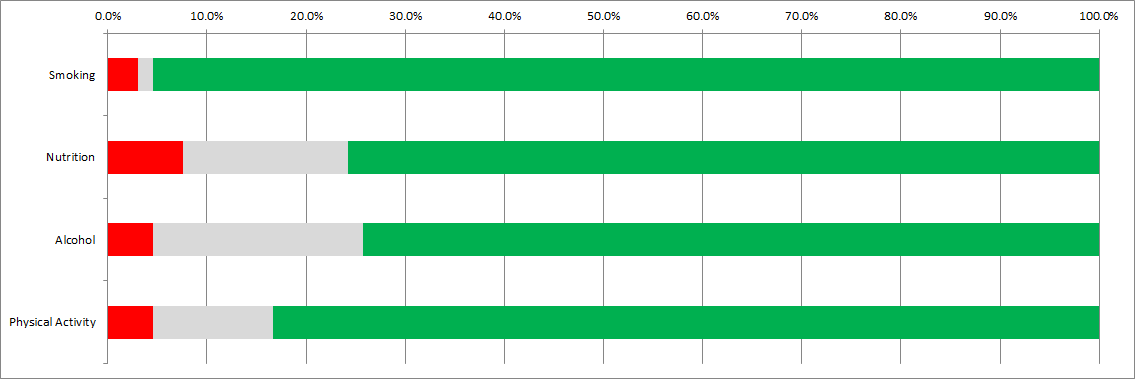
Friedman’s two-way ANOVA by ranks:
- p < 0.0001
- Statistically significant differences between the acceptability ratings of the SNAP factors in this scenario
- smoking enquiry was statistically significantly more acceptable than:
- nutrition (p < 0.0001, Wilcoxon signed rank test)
- alcohol (p < 0.0001, Wilcoxon signed rank test)
- physical activity (p = 0.007, Wilcoxon signed rank test)
Scenario 5
A person is feeling well but needs to have immunisation (injections) before going away on an overseas trip. They make an appointment to see the GP to get this done. They don’t have any other health concerns.
How acceptable is it for the GP to ask questions about this person’s:
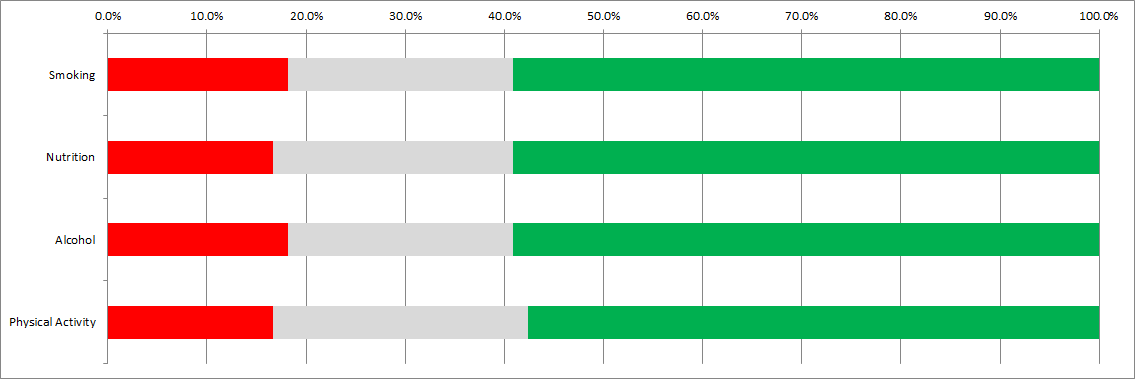
Friedman’s two-way ANOVA by ranks:
- p = 0.86
- no statistically significant differences between the acceptability ratings of the SNAP factors in this scenario
Scenario 6
A person has been suffering from a sore throat for the past few days. They think that it might be due to a cold. They make an appointment to see the GP.
How acceptable is it for the GP to ask questions about this person’s:
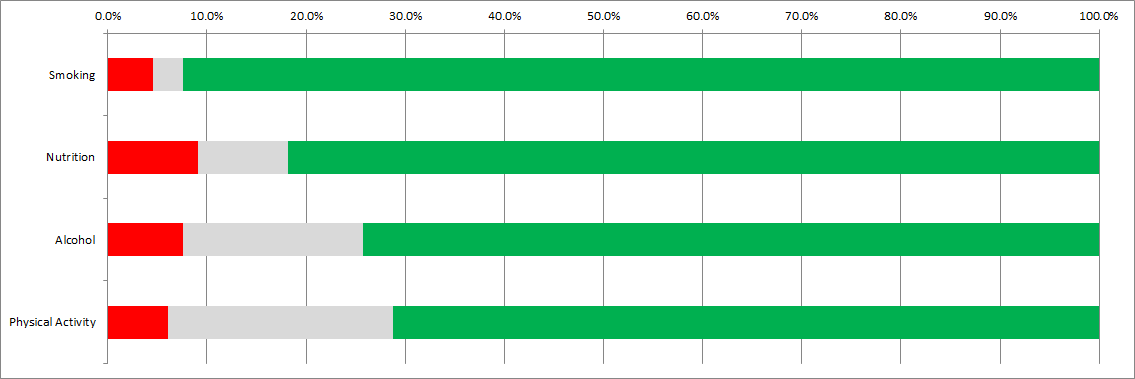
Friedman’s two-way ANOVA by ranks:
- p < 0.0001
- Statistically significant differences between the acceptability ratings of the SNAP factors in this scenario
- smoking enquiry was statistically significantly more acceptable than:
- nutrition (p = 0.015, Wilcoxon signed rank test)
- alcohol (p = 0.001, Wilcoxon signed rank test)
- physical activity (p < 0.0001, Wilcoxon signed rank test)
Scenario 7
A person developed low back pain two days ago after helping a friend move house. It has been quite bad and they had a poor night’s sleep from the pain. They are worried so decide to see the GP.
How acceptable is it for the GP to ask questions about this person’s:
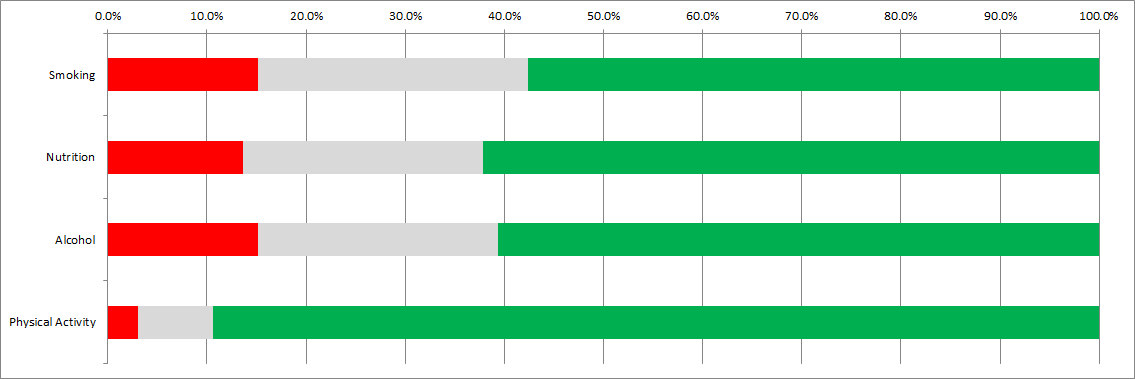
Friedman’s two-way ANOVA by ranks:
- p < 0.0001
- Statistically significant differences between the acceptability ratings of the SNAP factors in this scenario
- physical activity enquiry was statistically significantly more acceptable than:
- smoking (p < 0.0001, Wilcoxon signed rank test)
- nutrition (p < 0.0001, Wilcoxon signed rank test)
- alcohol (p < 0.0001, Wilcoxon signed rank test)
Scenario 8
A person needs to have paperwork from the government filled out by the GP. They are otherwise well and don’t have any other reason to see the GP.
How acceptable is it for the GP to ask questions about this person’s:
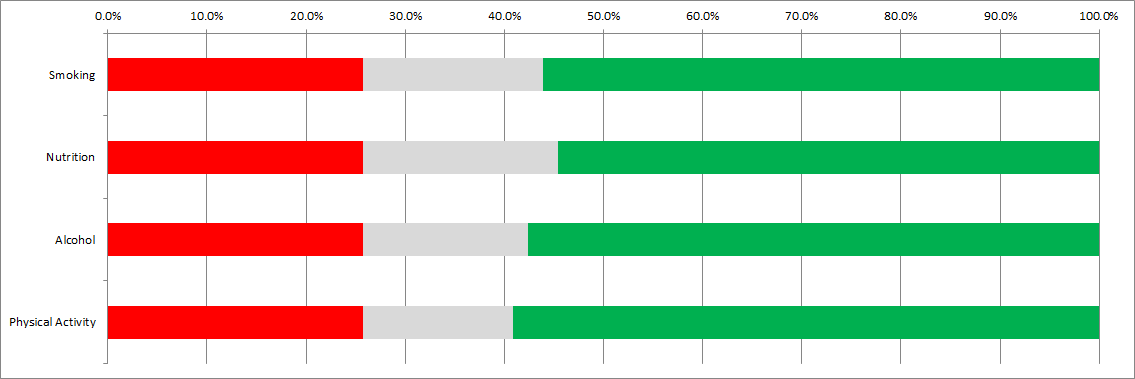
Friedman’s two-way ANOVA by ranks:
- p = 0.53
- no statistically significant differences between the acceptability ratings of the SNAP factors in this scenario
Scenario 9
A person has a chronic health problem that needs to be monitored with a regular blood test. They are due to have this test done. They make an appointment to see the GP to arrange a blood test request form.
How acceptable is it for the GP to ask questions about this person’s:
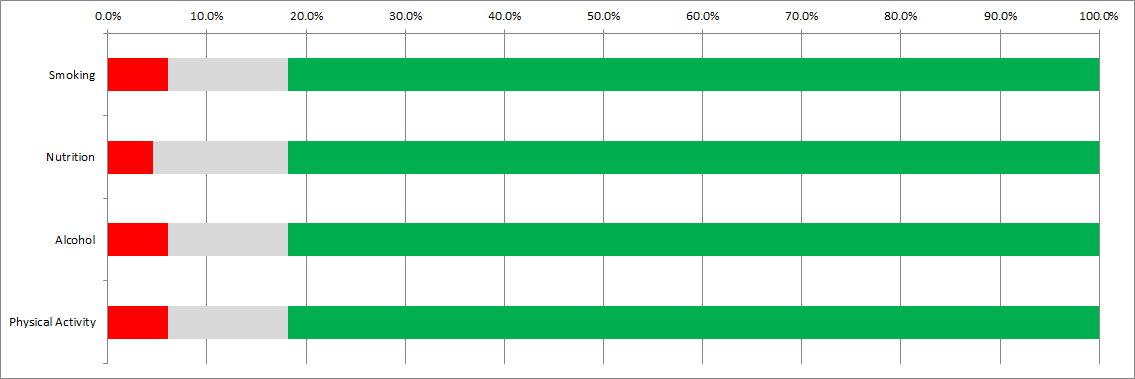
Friedman’s two-way ANOVA by ranks:
- p = 1.0
- no statistically significant differences between the acceptability ratings of the SNAP factors in this scenario
Scenario 10
A person recently developed an itchy rash on their skin. Their skin is red and they have been scratching at it. They decide to see the GP to see what can be done.
How acceptable is it for the GP to ask questions about this person’s:
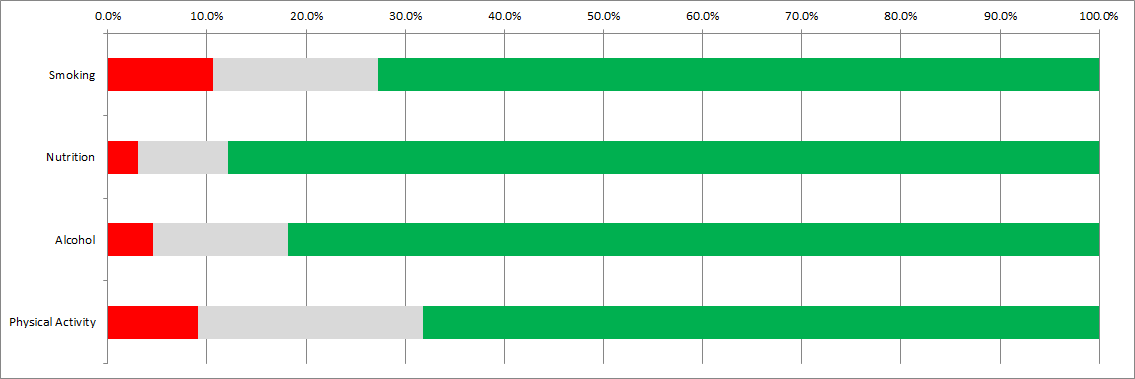
Friedman’s two-way ANOVA by ranks:
- p < 0.0001
- Statistically significant differences between the acceptability ratings of the SNAP factors in this scenario
- nutrition enquiry was statistically significantly more acceptable than:
- smoking (p = 0.002, Wilcoxon signed rank test)
- physical activity (p < 0.0001, Wilcoxon signed rank test)
- nutrition enquiry acceptability was not statistically significantly different to:
- alcohol (p = 0.059, Wilcoxon signed rank test)
Scenario 11
A person has long standing hypertension (high blood pressure). They take medicines for this condition. They make an appointment to the GP to get their blood pressure checked.
How acceptable is it for the GP to ask questions about this person’s:

Friedman’s two-way ANOVA by ranks:
- p = 0.71
- no statistically significant differences between the acceptability ratings of the SNAP factors in this scenario
Scenario 12
A person has been feeling very sad and blue over the past month. They have been teary and crying. They have been finding it difficult to enjoy usual things. Their sleep, energy levels and appetite have been affected. Their friend told them they seemed depressed and asked them to see the doctor.
How acceptable is it for the GP to ask questions about this person’s:
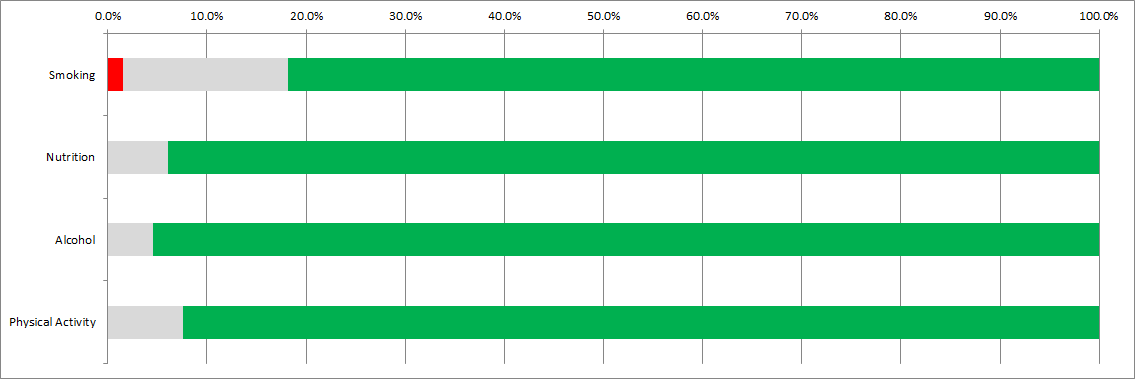
Friedman’s two-way ANOVA by ranks:
- p < 0.0001
- Statistically significant differences between the acceptability ratings of the SNAP factors in this scenario
- alcohol enquiry was statistically significantly more acceptable than:
- smoking (p = 0.002, Wilcoxon signed rank test)
- alcohol enquiry acceptability was not statistically significantly different to:
- nutrition (p = 0.56, Wilcoxon signed rank test)
- physical activity (p = 0.16, Wilcoxon signed rank test)
Scenario 13
A person has diabetes, a condition that causes high blood sugar levels. This has been controlled with lifestyle changes and some tablet medications. They make a routine appointment to see their GP to monitor their diabetes.
How acceptable is it for the GP to ask questions about this person’s:
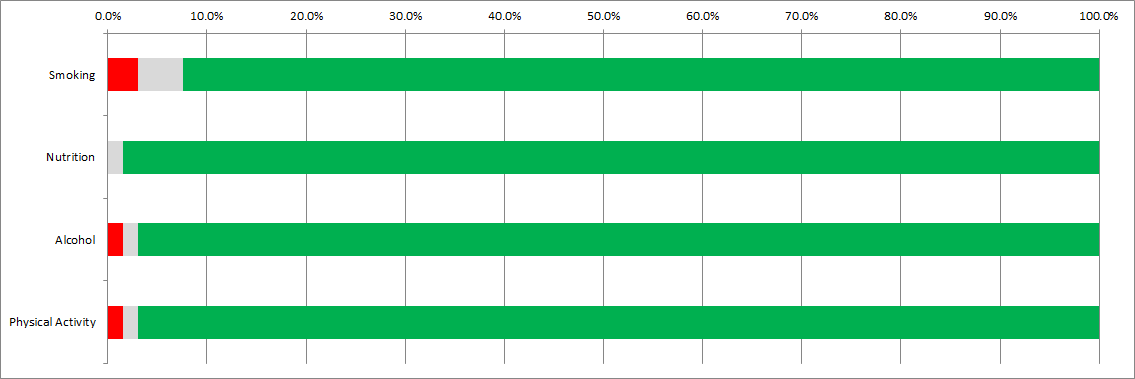
Friedman’s two-way ANOVA by ranks:
- p = 0.029
- Statistically significant differences between the acceptability ratings of the SNAP factors in this scenario
- however, nutrition enquiry acceptability was not statistically significantly different to:
- smoking (p = 0.063, Wilcoxon signed rank test)
- alcohol (p = 0.32, Wilcoxon signed rank test)
- physical activity (p = 0.32, Wilcoxon signed rank test)
Scenario 14
A person has been suffering from pain in the knees and hips. This has affected their walking. They have taken some mild pain killers suggested by the pharmacist, who told them they probably have arthritis. They go to see their GP about this problem.
How acceptable is it for the GP to ask questions about this person’s:
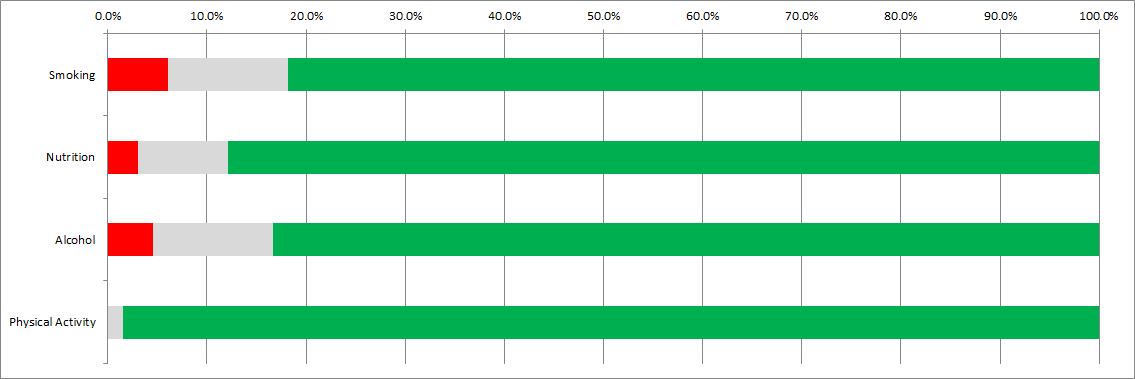
Friedman’s two-way ANOVA by ranks:
- p < 0.0001
- Statistically significant differences between the acceptability ratings of the SNAP factors in this scenario
- physical activity enquiry was statistically significantly more acceptable than:
- smoking (p = 0.002, Wilcoxon signed rank test)
- nutrition (p = 0.014, Wilcoxon signed rank test)
- alcohol (p = 0.004, Wilcoxon signed rank test)
Scenario 15
A person has high blood cholesterol levels. This was discovered a few years ago on a blood test. They have made some lifestyle changes. They make an appointment with the GP about this issue.
How acceptable is it for the GP to ask questions about this person’s:
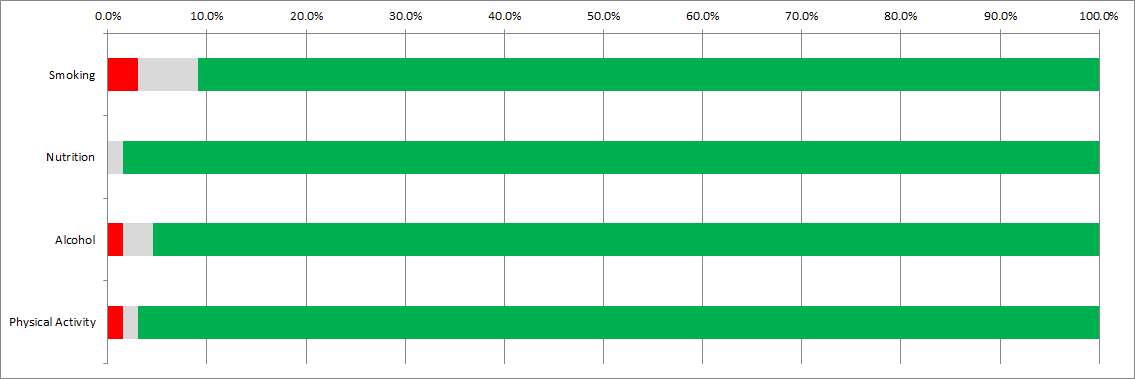
Friedman’s two-way ANOVA by ranks:
- p = 0.047
- Statistically significant differences between the acceptability ratings of the SNAP factors in this scenario
- nutrition enquiry was statistically significantly more acceptable than:
- smoking (p = 0.02, Wilcoxon signed rank test)
- nutrition enquiry acceptability was not statistically significantly different to:
- alcohol (p = 0.26, Wilcoxon signed rank test)
- physical activity (p = 0.32, Wilcoxon signed rank test)
Scenario 16
A person suffers from heartburn, especially after a heavy meal. This comes and goes, but has been worse lately. They go to see the GP.
How acceptable is it for the GP to ask questions about this person’s:
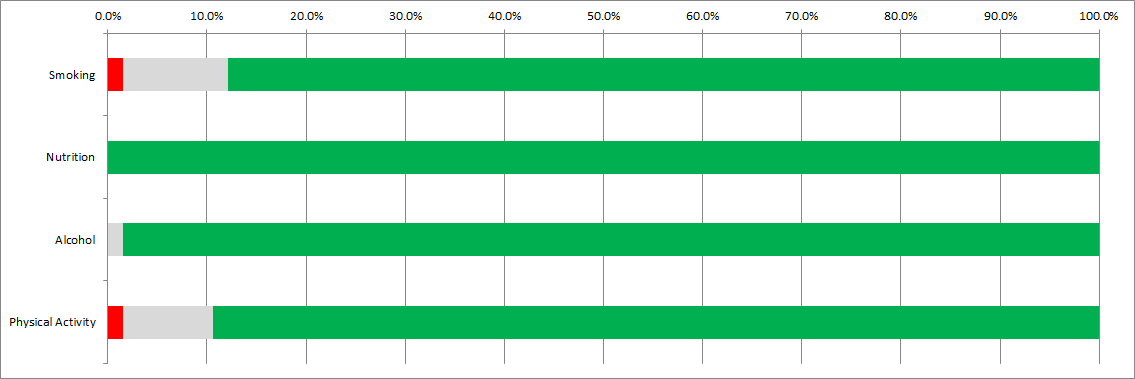
Friedman’s two-way ANOVA by ranks:
- p < 0.0001
- Statistically significant differences between the acceptability ratings of the SNAP factors in this scenario
- nutrition enquiry was statistically significantly more acceptable than:
- smoking (p = 0.007, Wilcoxon signed rank test)
- physical activity (p = 0.011, Wilcoxon signed rank test)
- nutrition enquiry acceptability was not statistically significantly different to:
- alcohol (p = 0.32, Wilcoxon signed rank test)
Scenario 17
A person has been suffering from a chesty cough for the past week. They have been coughing up yellow coloured mucus from the chest. They have felt hot and cold at times, sweaty, and have had a raised temperature. They wonder if they need antibiotics and make an appointment to see the GP.
How acceptable is it for the GP to ask questions about this person’s:
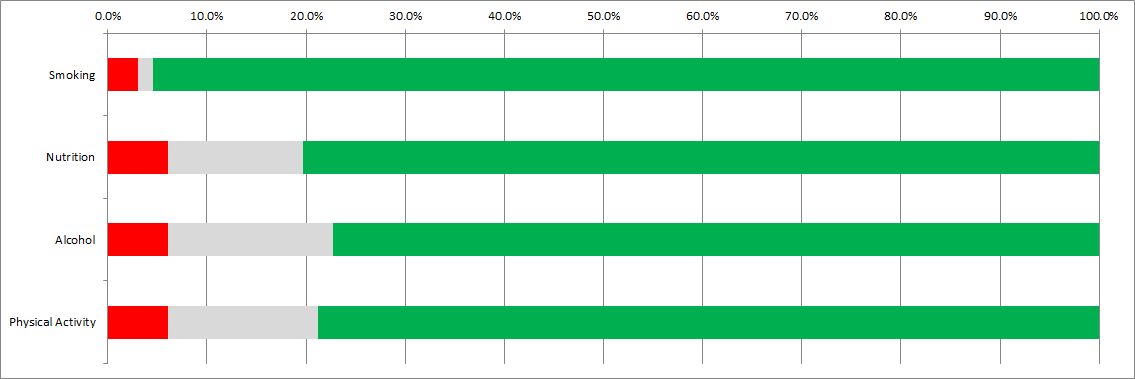
Friedman’s two-way ANOVA by ranks:
- p < 0.0001
- Statistically significant differences between the acceptability ratings of the SNAP factors in this scenario
- smoking enquiry was statistically significantly more acceptable than:
- nutrition (p = 0.001, Wilcoxon signed rank test)
- alcohol (p < 0.0001, Wilcoxon signed rank test)
- physical activity (p = 0.001, Wilcoxon signed rank test)
Scenario 18
A person has asthma, a condition that occasionally causes shortness of breath and wheezing. They use inhaled medicines to manage this condition. Recently, the wheeziness has become worse. The make an appointment to see the GP to see what they can do.
How acceptable is it for the GP to ask questions about this person’s:
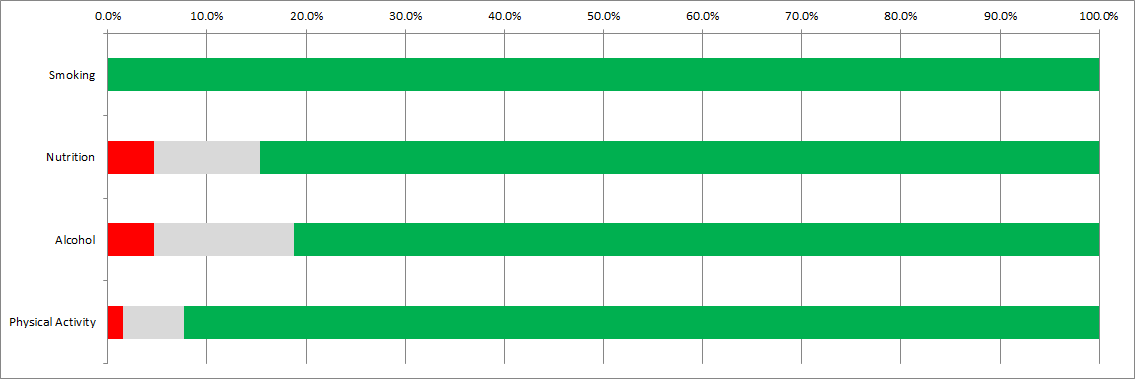
Friedman’s two-way ANOVA by ranks:
- p < 0.0001
- Statistically significant differences between the acceptability ratings of the SNAP factors in this scenario
- smoking enquiry was statistically significantly more acceptable than:
- nutrition (p = 0.004, Wilcoxon signed rank test)
- alcohol (p = 0.001, Wilcoxon signed rank test)
- physical activity (p = 0.0034, Wilcoxon signed rank test)
Scenario 19
A person has been feeling very worried and anxious. It is worse when they leave the house, and at times they have avoided going out due to this feeling. Sometimes when thoughts rush through their mind, they feel sick in their stomach and feel their heart beating very fast.
How acceptable is it for the GP to ask questions about this person’s:
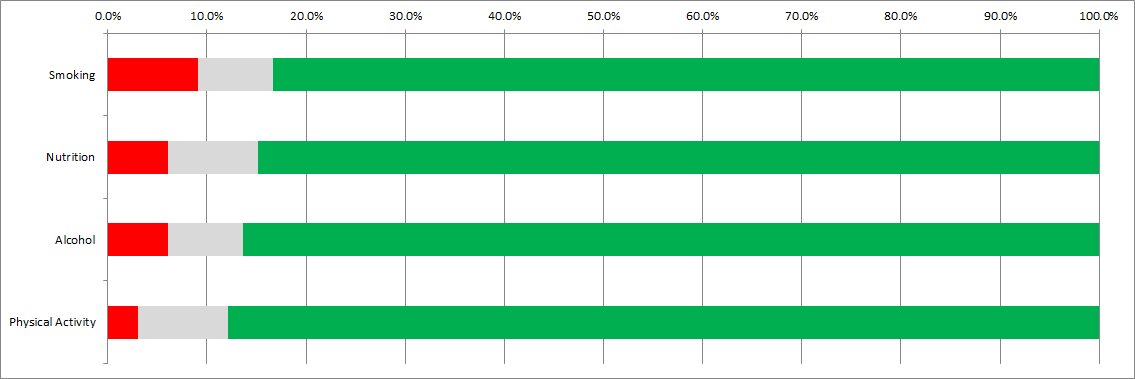
Friedman’s two-way ANOVA by ranks:
- p = 0.051
- no statistically significant differences between the acceptability ratings of the SNAP factors in this scenario
Scenario 20
A person has over the last 24 hours, had stinging and burning sensations when they pass urine. They have an urge to empty their bladder many times during the day. They think that they may have developed a urine/bladder infection.
How acceptable is it for the GP to ask questions about this person’s:
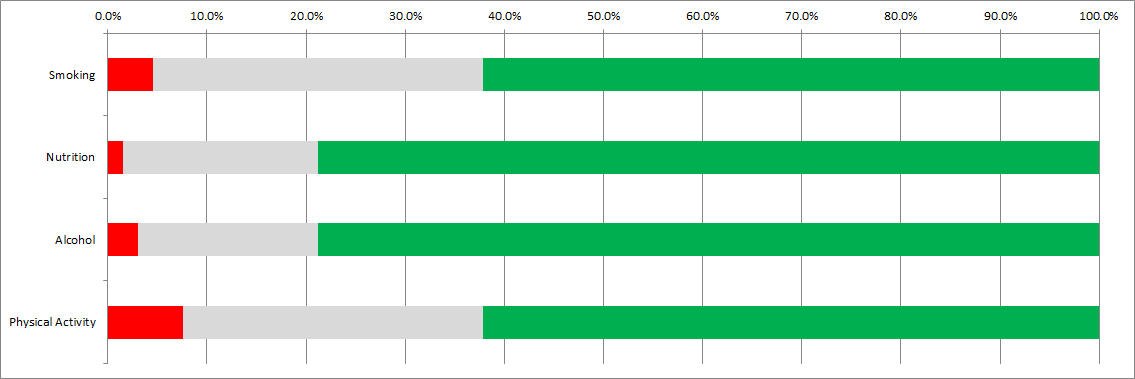
Friedman’s two-way ANOVA by ranks:
- p < 0.0001
- Statistically significant differences between the acceptability ratings of the SNAP factors in this scenario
- nutrition enquiry was statistically significantly more acceptable than:
- smoking (p = 0.001, Wilcoxon signed rank test)
- physical activity (p = 0.001, Wilcoxon signed rank test)
- nutrition enquiry acceptability was not statistically significantly different to:
- alcohol (p = 0.76, Wilcoxon signed rank test)


